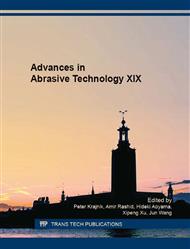p.109
p.115
p.127
p.133
p.139
p.145
p.151
p.158
p.167
Mirror-Like Surface Finishing of PCD by Fixed Abrasive Polishing
Abstract:
Polycrystalline diamond (PCD) has excellent properties such as high hardness, high chemical inertness, high wear resistance and a low friction coefficient. Thus, it has been expected to be applied to used in various mechanical parts such as sliding parts. However, diamond is difficult to machine owing to its high hardness and chemical inertness. Therefore, a highly efficient and high-quality machining process is required for PCD. In this study, the authors developed fixed abrasive polishing tools for the mirror-like surface finishing of PCD that contain mechanochemical abrasive grains with diamond grains. As a result of fixed abrasive polishing experiments, it was clarified that a mirror-like surface can be obtained by fixed abrasive polishing using a tool containing SiO2 and diamond abrasives. Moreover, it was found that the removal efficiency can be increased under a high-temperature condition.
Info:
Periodical:
Pages:
139-144
Citation:
Online since:
October 2016
Keywords:
Price:
Сopyright:
© 2016 Trans Tech Publications Ltd. All Rights Reserved
Share:
Citation:


